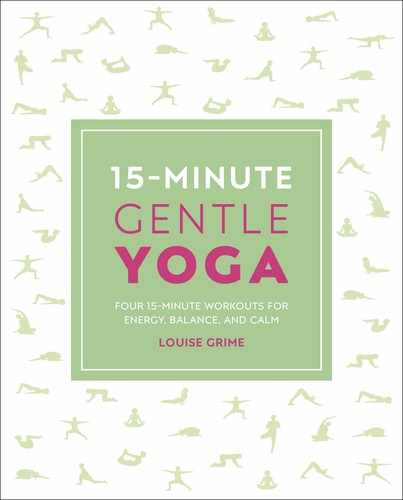
positive thinking
The last of the five principles of the yoga lifestyle, positive thinking and
meditation, encourages us to look at our habitual reactions and train the
mind to respond in ways more beneficial to well-being and peace. Steps
to simple meditation and relaxed breathing are on pages 106–107.
If you feel joyous and full of positive energy, you will
find that the people you mix with brighten up—and
when we laugh, life seems less onerous and
distressing, and the body’s systems, including
immune and nervous function, work more effectively.
Yoga teaches the art of turning negative thinking into
more positive thought patterns. Its methods are
gentle and begin by showing us how to become
aware of our current predilections. Try it out by
spending a minute or two after you wake observing
how you feel. Is your glass half full or half empty this
morning? Having gained this information, try not to
judge yourself, which can set up a thought-train of
negativity and self-loathing. Instead, reflect on how
it might encourage others to react to you as the day
goes on. Feel responsible for yourself and the way in
To make yourself more comfortable in the relaxation
pose, place an eye pad over your eyes, a firm bolster
under your knees, and cushion your neck and ankles.
US_104-105_Positive_thought.indd 104 21/06/2019 11:13

104/105
which your behavior will influence your future and
the lives of those you interact with today. Then
gently encourage your mind to be as open to
positivity as it can be. It may help to make an
affirmation—a positive statement in the first person
and the present tense—and to repeat it beneath your
breath like a mantra. Choose words that encourage
you to lighten up and let go of anxiety. You might
say, “I feel open and happy” or, “I feel ready to
respond to today’s challenges with relaxed positivity.”
RELAXATION POSE
Spending time in yoga relaxation postures can
support your efforts toward positivity—letting go of
your body and your thoughts in Corpse Pose needn’t
be reserved for the end of a yoga class. Drop into
this pose any time you would like to counter
negativity or feel in need of a little positive nurturing
by lying on your back with your legs apart and feet
flopping outward and your arms away from your
sides, palms facing upward and fingers gently curled
(top, opposite). Yoga teaches that the mind becomes
more settled and balanced when the body is aligned
symmetrically in rest. If you are pregnant, lie on your
side with pillows behind your back and under your
upper leg. To bring about a deep state of relaxation
Grab opportunities to relax as you move through the day.
You don’t need to adopt the formal Corpse Pose: sitting on
your heels and relaxing forward onto cushions for a few
minutes helps you maintain equanimity and positivity.
more quickly, cover your eyes with an eye pad,
and let its heaviness encourage you to allow
all five senses to retreat deep within.
Although this pose of positive relaxation may
appear easy, it is notoriously difficult to master, since
it asks you not only to still every part of your body,
but to gaze within at the “monkey mind,” which
jumps from thought to scattered thought, and may
dwell on negativity. It can also be tempting simply to
drift off, a common experience when you first start
yoga. Don’t beat yourself up. If you practice this
relaxation pose regularly—for 5–20 minutes every
day—your body will sink into ease more effectively
and your mind will remain simultaneously more
relaxed and more alert as you become a detached
observer, standing aside to watch your body and
breath become completely relaxed. There follows a
peaceful, naturally joyous, calm mind that equips us
to ride stressful situations and carry positive energy
out into the world.
ALL ABOUT YOGA
US_104-105_Positive_thought.indd 105 21/06/2019 11:13
..................Content has been hidden....................
You can't read the all page of ebook, please click here login for view all page.
